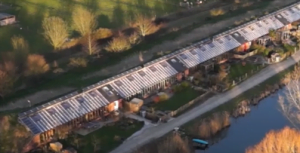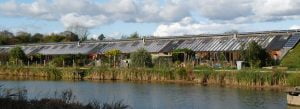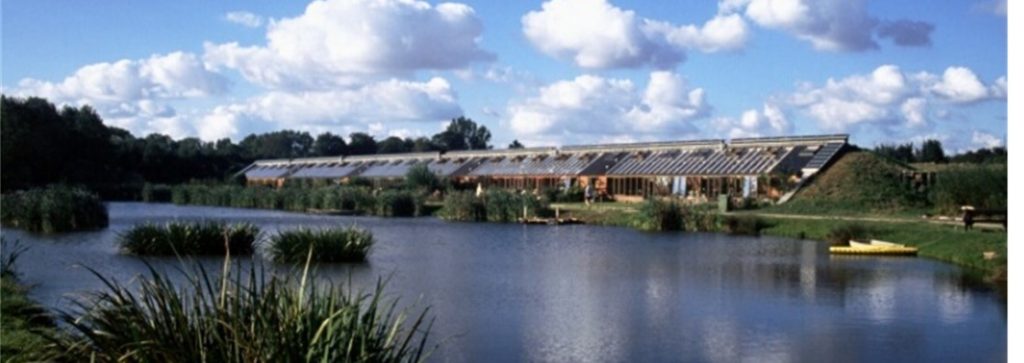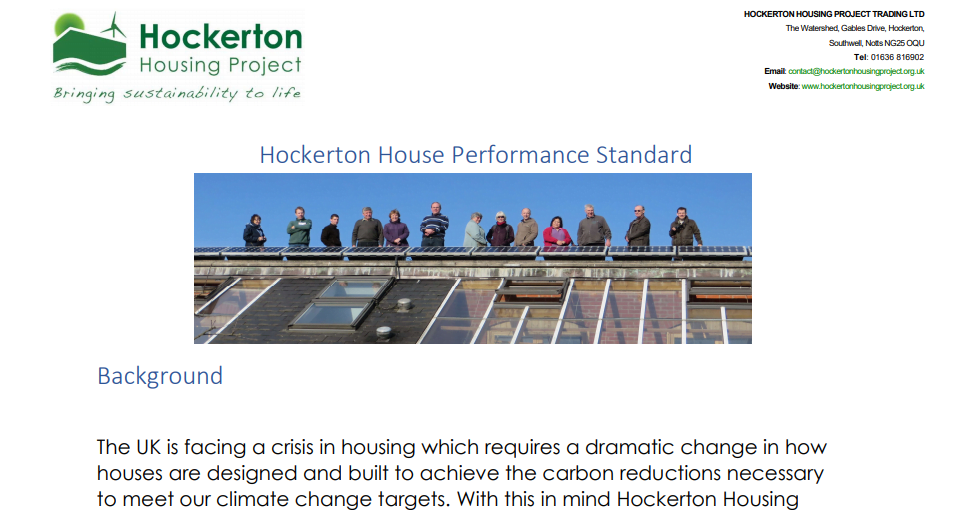House 3 FOR SALE
How to buy Contact us –2024.
There is a unique opportunity to purchase one of the most energy efficient homes in the UK, nestled in the rural village of Hockerton, near the bustling country town of Southwell and in the Hockerton Housing Project a world-renowned sustainable development. It sits in the heart of the community here. You can join the change with us.
We all value clean air and a good place to live, specially to bring up children. This home offers a fantastic opportunity to live in a house fit for the future. Warm and comfortable living with built in resilience and community all around. The house space is flexible and full of light with a very spacious conservatory to the south.

BUY AN ECO HOME IN HOCKERTON
It is built based on the earth sheltered high mass designs of world renown architects Dr Robert and Prof Brenda Vale. This is a very rear chance to live the dream in a sustainable development.
So how to buy this eco home 3 Gables Drive Hockerton. Please make enquiries via our email address contact@hockertonhousingproject.org.uk . We can send you the brochure, arrange a viewing and enable you to meet the neighbours.
This home can align your values with your living space, it’s a house fit for the future. The garden overlooks the lake, spacious and teaming with wildlife. There is also the opportunity to join the community business and share the facilities; Wind turbines, PV systems and self-contained water works.
The local pub is just a short walk away. Southwell just over the hill and offers good schools, shops, restaurants and many other amenities within a thriving community.
As Simon said “This is the largest house in the development and offers the most space for a family. The super insulated earth sheltered design with an internal heat battery works very well indeed at keeping heating bills to a minimum and the environmental impact low. It is adaptable to a 4 or 5 bedroom home suitable for families. It would be an ideal place to grow up in!”


Full details available in the sale brochure upon request.
We are helping the owners sell this property so Contact us now before it’s gone to arrange a viewing and put your offer in.
Property Location:
3 Gables Drive, Hockerton, Southwell, Notts NG25 0QU.
Tenure: 999-year lease with annual peppercorn rent in perpetuity.
Guide Price: Offers sought in the region of £600 000.

Eco homes or passive house or green houses come with many names but this is a very special opportunity!
Contact us now before it’s gone to arrange a viewing and put in your offer.

Hockerton Houses viewed over lake
Want to buy a house? A HOUSE IS FOR SALE! FIND OUT MORE.
Occasionally houses come up for sale in Hockerton Housing Project. The opportunity to buy a house is rare. It is always sad to see old residents move on and yet exciting to have new neighbours. There are a great deal of opportunities in the project, both socially and in our trading business. You get full access to both when you move in. Living here is a mix of individual time and space combined with community. The houses are self-contained but there are also lots of shared elements around them. The houses have their own front and back gardens with access to the land around them jointly. This mix has proven to be popular with families.
Children have always loved playing here in a community space having lots of fun. Always very comforting to know that the neighbours will keep a weather eye out for them too. We have found it an incredibly supportive and safe place for children. In fact one of my children has come back to live here as a grown up! What better testament is there than that.
The grown-up stuff. As a community we have to cooperatives set up one for running the community business and one for organising the domestic side. These are Hockerton Housing Project Trading Ltd and Hockerton Housing Project Ltd. Each of these has its own organisation structures. More information on this and how to join can be found here. We suggest you read the community rules in these companies’ documents before joining the group and we will help you understand them if you come along to one of our community meetings. They come to life in a meeting!
Please contact us if you think you might want to buy one of our houses.
Hockerton Housing Project is excited to announce it has released its own housing standard fit for the future world of zero carbon houses. It is called the Hockerton House Performance Standard and outlines the requirements that houses will need to be built to in order to achieve a sustainable low impact world. Unlike the Passivhaus standards these are free to use and go far beyond what Passivhaus can achieve. They are there to inspire!
Minister for Housing Nick Raynsford visiting Hockerton Housing Project

Since the visit of the Minister for Housing Nick Raynsford at our opening we have been pushing the boundaries of construction. Our latest development of nine houses is taking shape with the walls going up in Howgate Close, Eakring with a predicted SAP score of 142! Jerry Harrall is delivery the project and writing Howgate Close, blog.

Howgate close foundations
The UK is facing a crisis in housing which requires a dramatic change in how houses are designed and built to achieve the carbon reductions necessary to meet our climate change targets. With this in mind we are proposing standards of construction to inspire people to construct very high-performance houses factoring in embodied energy and within sustainable communities. The lifestyle of the people living in houses affects emissions of carbon significantly so cannot be ignored. A well-engineered house and designed community space will help inspire them to reduce their carbon emissions. Inspiration can lead to action given the right environment.
The imbedded House Performance Standards are performance based to allow individual designers and builders to create their own solutions. This should encourage creativity and enable future solutions to be incorporated in the finished houses.
These performance standards have been inspired by Dr Robert Vale, Professor Brenda Vale, Mr Nick Martin and the practical experience of the members of Hockerton Housing Project since 1993. They have drawn on General Information Report 53 produced for the Department of Environment Transport and the Regions by the Building Research Energy Conservation Support Unit. More recently the Leti “Net Zero Operational Carbon” targets have pushed us!
There are five subsidiary standards:
- Hockerton-Zero,
- Hockerton-Heat,
- Hockerton-Embodied
- Hockerton-Water,
- Hockerton-Community
Combining these five standards will create houses fit for the future.
If you are a lecturer or student and want to design your own tour find out more here.
We have now been running our aquaponics system for a year. It was installed as part of a PhD project emerging from Sheffield Hallam University, exploring how a lay-person would take to soil-free gardening, and capturing lessons that may prove of use if the approach is to be taken up more widely.
Last September we posted our lessons from the initial design and cycling of the aquaponics system, and here is the experience gained from using it in earnest.
- Temperature: we are still waiting for the live temperature monitoring system planned by the University, but temperatures in the tank got down to 5C in this uncharacteristically long, cold winter. We keep carp in our system in part due to their ability to cope in a range of temperatures, and whilst their activity seemed to slow, there was no significant problem.
- Temperature time-lag: the salads planted in the spring were a lot faster growing in the soil than aquaponics. Without monitoring data it is hard to specify the cause but it is likely that problems with the auto-siphon (see 8) slower supply of feed and oxygen, and we suspect that the temperature of the water was slower to rise than that of the soil.
- Over-winter plants: our main problem over winter was vermin rather than temperatures. The kohlrabi were eaten in one night. But other plants thrived, and we had a supply of green leaves from Mizuna, chard and spinach plants through til Spring.
- Thermal mass: Another success were the tomatoes which survived 6 weeks longer than those a meter away that were planted in soil. This may be due to their later planting, but their close proximity to heat-storing thermal mass may also play a part. The mass is in the clay balls in which they are planted, the water, and the dense concrete blocks that support our growing beds – against which the tomatoes were trailed.
- Minerals: We share the produce grown between our five households, and concern was raised about whether they were as healthy as soil-grown plants due to a lack of minerals. This prompted some further reading but we were on the right track:
- Maxicrop to add micronutrients in our initial cycling
- Rocks from our carp pond helped introduce naturally-occuring bacteria
- To this we added, after three months, composting worms which seem to be surviving well, and there is no sign of mineral deficiency in the leaves or crops.
- Sowing medium: some seeds have self-sown (tomatoes), and some peas and beans have successfully grown from seed scattered in the beds, but vermin were a significant problem – perhaps due to the long winter. To get round this we started seedlings off in an Ikea hydroponics kit in a conservatory, made more sustainable by using our own sheeps’ wool to form the sowing medium, instead of mineral wool.
- Evaporation: again, we are yet to receive the monitoring equipment but it seems more water is evaporating than we would expect, with the system requiring approximately 300 litres top-up every 2-3 weeks in growing season.
- Cleaning: it took a long time to select fish food and it’s not clear we made the right choice. A lot of it is either not properly digested or dissolved and so occasionally blocks the pipes or is spewed out in to the last growing bed in the system. This bed is now protected to some degree by a sieve under the inlet pipe, but we would advise others to experiment with different feeds before buying a 25kg bag! The outcome of this was that the inlet water slowed to the point it was insufficient to trigger the auto-siphons, the growing beds did not drain once flooded (unless triggered manually) and so plants were starved of oxygen for much of the day.
The plants we are now testing for the first time (for us, at least) are French beans, squash, kale and spring onions. The French beans are densely planted, and are producing many more although much smaller, finer beans than those planted in neighbouring soil; the squash and courgette are slower to take off than those planted in soil, as is the kale, so it is still early days; but it is a delight to finally grow some spring onions which have never taken off in our soil beds.
You can follow more of our food-growing ventures on Instagram.
Last year we embarked on a trial of aquaponics in a domestic setting, as part of a PhD undertaken by John Grant of Sheffield Hallam University. Our related blogs are not a guide in themselves, but perhaps help fill some of the gaps we found in existing literature. If you want an introductory guide we recommend Sylvia Bernstein’s Aquaponic Gardening.
This blog follows up on our previous post with a review of our first 6 weeks of hosting fish, and the snags we had with our initial build. There was a gap of some months as having built the physical system we were nervous of the temperatures that could be reached in our polytunnel and so waited until the summer so we could monitor temperatures before introducing fish to the system.
The build
Our first visit to the polytunnel after the winter break was a bit of a shock, as the foundations for the water tank had subsided. This meant we had to empty the water tank and dig out the earth around the sump tank to the extent that we could embed boards to stop the earth from collapsing against the tank.
Lesson learnt: if placing the fish tank over an IBC sump tank, box in the sump tank – however firm you think the ground is. We’d also suggest that the top water tank is filled some time before adding fish, if you are not building on a very firm base. The fix for our problem would have been a lot harder if we had already put fish into the top tank, and very disheartening if cycling had already started.
Having plumbed the growing beds’ inlets and outlets we added water to check the autosipons worked. It is worth doing this without the clay balls in place. We also discovered a leak in one of the tanks at this point.
Lesson learnt: It is much easier to fix these things before the clay balls are added.
Down the track we have realised that it will be difficult for us to alter the height of the outlet pipe that sits up in the tank. Ours is a single piece of pipe down to the junction with the outlet pipe that returns to the sump tank.
Lesson learnt: Plumb the system so that the pipe within the tank can be removed.
We have also realised that whilst we take water from close to the top of the fish tank, this can still carry a fair amount of gunk (technical term). It is likely that this affects the water flow.
Lesson learnt: Install a settling tank in the plumbing immediately after the fish tank.
Which fish?
Originally we had hoped to stock Tilapia or trout, but were concerned about the need to heat or cool the tanks. Having reviewed various guides it became clear that carp were one of the most robust fish when it comes to temperature range and fluctuations. And, as we have a lake full of carp on our doorstep, carp it was. We don’t normally eat carp because it is very muddy when fished from the lake, but we realised that keeping it in the aquaponics fish tank offers a way of cleaning out their systems,and perhaps make them more appetising.
We spent a significant amount of time trying to source organic fish food but it seems to be available solely to large scale fish farms. The first batch was a floating feed from a local ‘World of Water‘, which we have followed up with a slow sinking feed for coarse fish from Skretting. We are also considering how we can farm duckfeed as a high-protein green for them.
Lesson learnt: We recommend a floating feed. Whilst carp are, naturally, bottom-feeders, they were happy eating from t he surface after 1-2 days, and this gives you a chance to check on them.
he surface after 1-2 days, and this gives you a chance to check on them.
Whilst considering the animal kingdom, it is worth noting that we found a frog in the sump tank one day. It is worth ensuring that the tank is sealed, and/or providing a route out for anything that decides to go for a swim.
Cycling the system
We used the Murray- Hallam cycling technique to start the system off. This means adding liquid seaweed and adding plants, and then waiting for 2 weeks before adding fish. There was concern about the pH of the water, which was higher than the ‘ideal’ range given in the literature. However, having tested the pH of the lake from which the fish would be taken, we realised they were the same, so no action was taken on its acidity. This has dropped over time.
We were also able to introduce some rocks from the lake into the growing beds. They carry ‘healthy bacteria’ that would help speed up the cycling process.
3 solar powered oxygenators were used over the summer, which are now powered by the mains as daylight hours start to reduce. We cannot currently monitor oxygen levels in the water, but hope to get a more efficient approach to the energy consumption in future.
The rationale for this approach was that the water would be prepared for the fish. However, 2 weeks into their residence we found a number dead. This hit us hard as the whole idea of this approach had been to avoid stressing the fish. It appears to have happened because the stocking levels were too high, and they received more food than necessary due to some enthusiastic helpers. We reduced the fish levels to a quarter of that suggested in the literature, and their feed is also given at a lower rate than suggested. A month on the pH, Ammonia, Nitrite and Nitrate levels remain spot on.
Lesson learnt: Use the Murray-Hallam method but introduce the fish very gradually, and give a single person responsibility for feeding. It is better to lose some early plants than put the fish through stress.
Data monitoring
 We are yet to start the formal monitoring of the system but readings were taken daily during cycling and the first two weeks of the fish residency. Now the system is up to speed we are testing pH, ammonia, nitrite and nitrate levels on a weekly basis. We found (but don’t know if this is the norm) that the Nitrite level rose and fell very quickly, and the Nitrate level rose to 80ppm on the day after the fish were introduced and haven’t fallen much since.
We are yet to start the formal monitoring of the system but readings were taken daily during cycling and the first two weeks of the fish residency. Now the system is up to speed we are testing pH, ammonia, nitrite and nitrate levels on a weekly basis. We found (but don’t know if this is the norm) that the Nitrite level rose and fell very quickly, and the Nitrate level rose to 80ppm on the day after the fish were introduced and haven’t fallen much since.
We also visually check the water levels and flow rates in the tanks and from the outlets into the grow beds. We have found that we have to add around 300 litres of water on a fortnightly basis over the summer, suggesting that evaporation is more of an issue than we expected.
Our greatest concern is the temperature, as this is very difficult to control, and there is no data available on this for our particular site (a polytunnel in the UK). The good news is that the water appears to limit temperature swings with its highest temperatures on the hottest days reaching 5 degrees less than the outside air, and staying 5 degrees warmer than the outside air overnight. It is likely that the water will provide a similar cushioning effect over winter, and it is hoped we will have full temperature monitoring to provide more information to protect our fish, and help others with their aquaponics plans.
Output!

First plants go in, and visibly struggle to find nutrients
The planting of the grow beds was circumstantial rather than planned. A tomato cutting or two have taken hold surprisingly quickly and are now fruiting. Some supermarket coriander plants thrived for around 6 weeks but didn’t survive the first cold night of the autumn, whilst some strawberry plants surprisingly fruited within weeks. Spare pea seedlings grew, but failed to fruit. And of the greens, the lettuces have taken well but various brassicas have been eaten by unseen bugs (or slugs?).
At this point it seems that the output is different to that achieved in soil. Some leaves, like spinach and mizuna, are growing well and deliver on taste and texture; but other lettuces are just too limp. Next year we will need to more consciously trial what works and what doesn’t.
And finally, perhaps most exciting for a beginner, that thing where people just scatter seeds into the grow beds – it works! In early August, in a rush before going on holiday, I sprinkled a handful of dwarf peas into the bed and covered it with a single layer of clay balls. Those plants are now growing nicely and producing flowers. Light levels may now be too low to deliver many peas this year, but they may well survive the winter ready to grow on in the Spring.












 he surface after 1-2 days, and this gives you a chance to check on them.
he surface after 1-2 days, and this gives you a chance to check on them. We are yet to start the formal monitoring of the system but readings were taken daily during cycling and the first two weeks of the fish residency. Now the system is up to speed we are testing pH, ammonia, nitrite and nitrate levels on a weekly basis. We found (but don’t know if this is the norm) that the Nitrite level rose and fell very quickly, and the Nitrate level rose to 80ppm on the day after the fish were introduced and haven’t fallen much since.
We are yet to start the formal monitoring of the system but readings were taken daily during cycling and the first two weeks of the fish residency. Now the system is up to speed we are testing pH, ammonia, nitrite and nitrate levels on a weekly basis. We found (but don’t know if this is the norm) that the Nitrite level rose and fell very quickly, and the Nitrate level rose to 80ppm on the day after the fish were introduced and haven’t fallen much since.